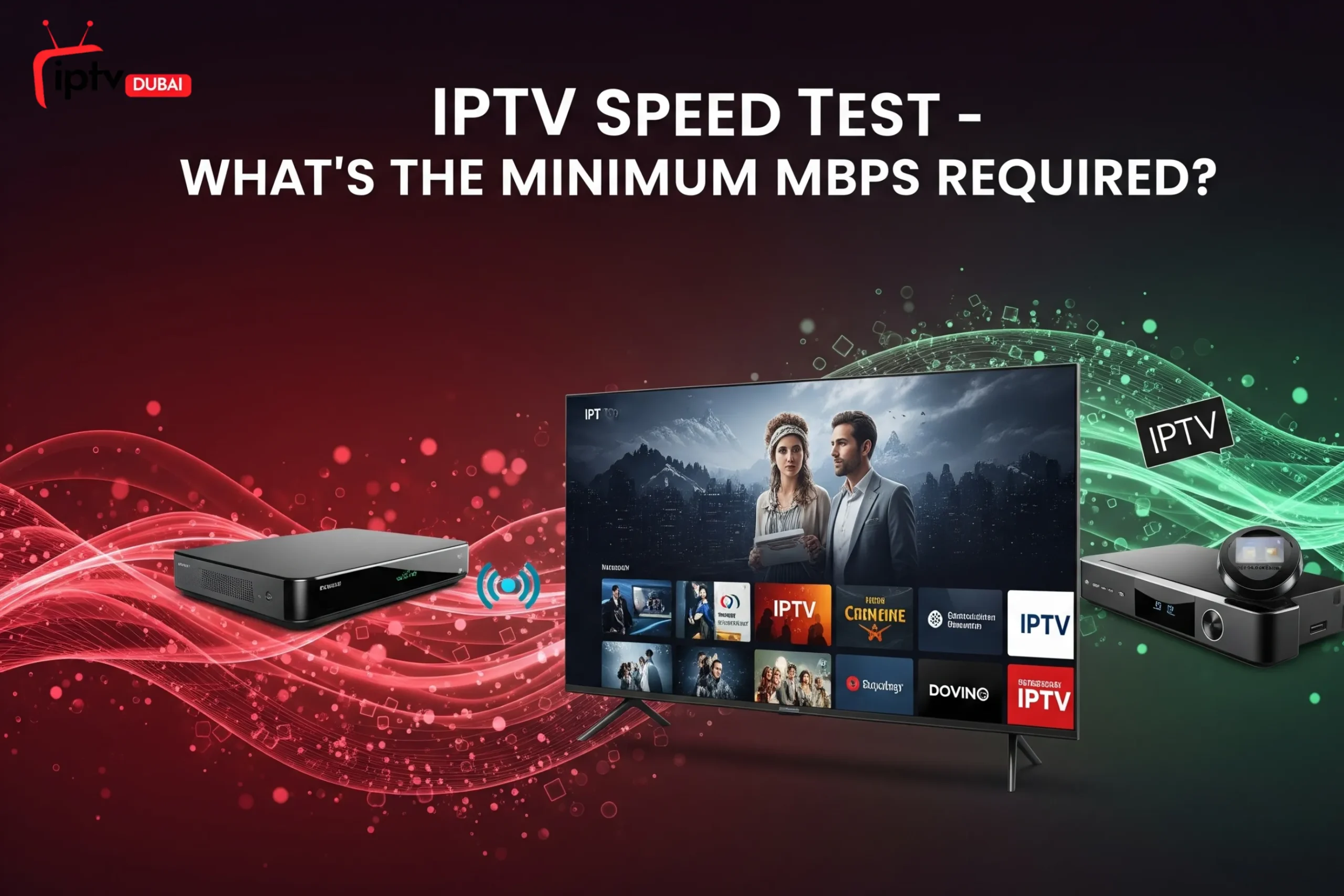Blog
IPTV Speed Test – What’s the Minimum Mbps Required?

To stream IPTV without buffering or interruptions, a minimum of 3–5 Mbps is needed for Standard Definition (SD), 5–10 Mbps for High Definition (HD), and 25 Mbps or more for 4K content. However, Mbps is only one part of the equation. Latency, jitter, congestion, and device quality all affect real-time IPTV performance. This guide examines all the network metrics that affect streaming quality and provides guidance on measuring and optimizing them for a stable viewing experience.
KEY TAKEAWAYS
- Minimum Mbps for IPTV:
- SD: 3–5 Mbps
- HD: 5–10 Mbps
- 4K: 25+ Mbps
- Beyond Mbps: Latency (under 50ms), jitter, network congestion, and device quality are equally crucial for smooth IPTV.
- Optimize Your Network: Use Ethernet for stability. For Wi-Fi, optimize router placement and consider extenders/mesh.
- Troubleshoot Buffering: Check internet speed, clear app cache, reboot devices, and consider ISP throttling (test with a VPN).
- VPN Benefits: Enhances privacy, bypasses geo-restrictions, and prevents ISP throttling for better streaming.
Role of Speed Tests in Evaluating Internet Connection
IPTV speed tests serve as critical diagnostic tools to evaluate the reliability and strength of your internet connection for streaming. These tests assess more than just bandwidth—they help detect latency issues, packet loss, and congestion, which are just as crucial as Mbps when streaming live TV or on-demand content. For IPTV to function correctly, your connection must support consistent downstream throughput, low-latency responses, and minimal fluctuations during peak usage.
Key Metrics to Measure: Latency, Network Congestion
Latency refers to the delay between sending a request and receiving a response. High latency causes buffering and delays during IPTV playback, especially for live streams. The ideal latency for IPTV is under 50 milliseconds.
Network congestion occurs when too many devices share bandwidth or when your ISP routes traffic inefficiently. It leads to unstable speeds and poor IPTV performance. Running multiple speed tests at different times of the day can reveal signs of congestion affecting your service.
Recommended Speeds for IPTV Streaming
The speed required for IPTV depends on the video resolution, the number of devices in use, and the streaming provider’s compression technology. While Mbps is the standard metric, IPTV relies on stable delivery rather than bursty bandwidth. Therefore, consistent speeds matter more than just peak values. Below are the ideal speed ranges for different types of IPTV content.
Minimum Mbps for Standard Definition (SD)
SD (480p) IPTV streams require a consistent download speed of 3–5 Mbps per device. This is sufficient for smaller screens, such as tablets or budget Smart TVs, where resolution is less critical. Users on limited data plans or slower DSL connections can still enjoy IPTV with SD streams, provided the connection remains stable.
Minimum Mbps for High Definition (HD)
HD (720p or 1080p) content typically requires 5–10 Mbps of steady downstream bandwidth. Most modern IPTV apps default to HD streaming, making this the practical minimum for a home with multiple users. Fluctuations below 5 Mbps can cause buffering and audio-video synchronization issues during playback.
Minimum Mbps for 4K Content
4K IPTV (2160p) content demands a minimum of 25 Mbps, though some providers recommend 35 Mbps to accommodate bitrate spikes and live encoding. Additionally, 4K requires higher network stability, making Ethernet connections and high-performance routers essential for uninterrupted streaming.
Comparison with Requirements for Popular Streaming Platforms
While IPTV providers differ in terms of compression and quality, their speed requirements align with those of OTT services, such as Netflix or YouTube. The table below summarizes the typical speed guidelines:
| Streaming Quality | IPTV | Netflix | YouTube |
| SD (480p) | 3–5 Mbps | 1.5 Mbps | 1–3 Mbps |
| HD (1080p) | 5–10 Mbps | 5 Mbps | 5–8 Mbps |
| 4K (UHD) | 25–35 Mbps | 15–25 Mbps | 20–25 Mbps |
IPTV, primarily live streaming, is more sensitive to network jitter and congestion, making consistent bandwidth delivery more important than peak Mbps.
Network Infrastructure for Optimal Streaming
A high-speed internet plan doesn’t guarantee IPTV performance unless your home network can handle that speed across all devices. Infrastructure—including router type, wiring, and layout—plays a direct role in streaming reliability. IPTV requires low interference, fast data transfer, and continuous connectivity, which is often only possible with proper network planning and design. and design
Wired vs. Wireless Networks
Wired connections (Ethernet) offer greater stability and faster throughput than wireless. They eliminate common issues like signal drops, interference, or bandwidth splitting. For streaming HD or 4K IPTV content, a wired connection is highly recommended, especially for Smart TVs or Android TV boxes.
Benefits of Using Ethernet Connections
Ethernet connections ensure:
- Consistent download speeds without wireless interference
- Lower latency and faster request-response cycles
- No signal dead zones, which are common in multi-floor homes
When possible, prioritize Ethernet over Wi-Fi for any IPTV-capable device to reduce the risk of buffering or signal loss.
Enhancing Wireless Performance: Wi-Fi Extenders and Routers
In cases where Ethernet is not feasible, Wi-Fi performance must be optimized using:
- Dual-band routers (2.4GHz and 5GHz)
- Mesh Wi-Fi systems for multi-room coverage
- Wi-Fi extenders to eliminate dead zones
Place your router in a central, unobstructed location, avoiding placement near appliances, walls, or metal surfaces. Also, consider QoS settings to prioritize IPTV traffic over background devices.
Troubleshooting Common Streaming Issues
Even with the right speed, IPTV issues may still occur due to hardware limitations, software misconfigurations, or ISP-related constraints. Understanding the underlying causes of interruptions helps ensure consistent performance across your IPTV setup.
Causes of Buffering and Lag
Buffering is most often caused by:
- Insufficient or unstable internet speed
- High network latency or jitter
- Overloaded IPTV servers (from the provider side)
- Interference on Wi-Fi networks
A speed test might show good Mbps, but if latency or congestion is high, buffering still occurs.
Solutions for Improving Device Performance
Performance issues can often be fixed by:
- Clearing the cache of the IPTV app
- Closing unused background applications
- Rebooting the device regularly
- Ensuring the device has sufficient RAM and storage
Android-based devices, such as Firesticks or Android TV boxes, should be updated regularly and used with lightweight IPTV apps like TiviMate or IPTV Smarters.
How to Optimize Network Settings
Router and device settings can be optimized to reduce buffering:
- Enable QoS (Quality of Service) and assign high priority to IPTV devices
- Change DNS servers to faster public options (e.g., 8.8.8.8 or 1.1.1.1)
- Allocate static IP addresses for IPTV devices
- Place routers away from interference sources
These steps ensure consistent traffic prioritization and reduce delays in data transmission.
Identifying and Combating ISP Throttling
Some ISPs throttle streaming data during peak times, which can affect IPTV performance even with sufficient Mbps.
To detect throttling:
- Run speed tests while not streaming vs. while streaming
- Use a VPN and compare performance
If the VPN improves streaming quality, your ISP is likely throttling IPTV-related traffic. In this case, continuing to use a VPN is recommended.
Utilizing VPNs for IPTV
A VPN (Virtual Private Network) secures your IPTV traffic, masks your IP address, and allows access to geo-blocked content. It also prevents ISPs from detecting or throttling IPTV traffic, a common issue with unregulated IPTV services.
Benefits of Using a VPN
VPNs for IPTV provide:
- Privacy from ISPs and third parties
- Bypass of geographic restrictions
- Protection against bandwidth throttling
- Ability to use IPTV services while traveling abroad
Choose a no-log VPN provider with high-speed servers to avoid buffering.
How VPNs Can Enhance the Streaming Experience
- Improve connection routes by accessing closer VPN nodes
- Unlock IPTV libraries restricted by region
- Prevent throttling by disguising streaming traffic
- Allow secure access to unofficial IPTV providers
Top VPN services for IPTV include NordVPN, ExpressVPN, and Surfshark, all of which offer optimized servers for streaming traffic.
Conclusion
An effective IPTV setup demands more than Mbps numbers. While 3–5 Mbps supports SD, 5–10 Mbps covers HD, and 25+ Mbps is required for 4K, stability is everything. Make sure to:
- Use speed tests to analyze latency, jitter, and congestion
- Prioritize Ethernet connections over Wi-Fi when possible
- Optimize router settings and device configuration
- Use a VPN to protect privacy and bypass throttling
With the proper infrastructure and setup, IPTV provides a powerful alternative to traditional cable, streamed on your terms, with minimal interruptions.



















